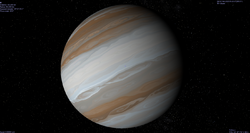Astronomy:47 Ursae Majoris c
 An artist's impression of 47 UMa c | |
| Discovery | |
|---|---|
| Discovered by | Fischer, Butler, and Marcy et al. |
| Discovery site | |
| Discovery date | 15 August 2001 19 March 2002 (confirmed) |
| Doppler spectroscopy | |
| Orbital characteristics | |
| 3.6 ± 0.1 Astronomy:astronomical unit|astronomical units (539 ± 15 million kilometres)[1] | |
| Eccentricity | 0.098+0.047−0.096[1] |
| Orbital period | 2391+100−70[1] d ~6.55 y |
| astron|astron|helion}} | 2,452,441+628−825[1] |
| 295+114−160[1] | |
| Semi-amplitude | 7.0 ± 2.3[2] |
| Star | 47 Ursae Majoris |
47 Ursae Majoris c (abbreviated 47 UMa c), formally named Taphao Kaew (/təˌpaʊ ˈɡaʊ/ tə-POW GOW;[3] Thai: ตะเภาแก้ว [tāpʰāwkɛ̂ːw]) is an extrasolar planet approximately 46 light-years from Earth in the constellation of Ursa Major. The planet was discovered located in a long-period around the star 47 Ursae Majoris. Its orbit lasts 6.55 years and the planet has a mass at least 0.540 times that of Jupiter.
Name
The planet is named after one of two sisters associated with a Thai folk tale.[4]
In July 2014 the International Astronomical Union launched NameExoWorlds, a process for giving proper names to certain exoplanets and their host stars.[5] The process involved public nomination and voting for the new names.[6] In December 2015, the IAU announced the winning name was Taphao Kaew,[7] submitted by the Thai Astronomical Society of Thailand.
Discovery
Like many known extrasolar planets at the time, 47 Ursae Majoris c was discovered by detecting changes in its star's radial velocity caused by the planet's gravity. This was done by measuring the Doppler shift of the star's spectrum.
At the time of discovery in 2001, 47 Ursae Majoris was already known to host one extrasolar planet, designated 47 Ursae Majoris b. Further measurements of the radial velocity revealed another periodicity in the data unaccounted for by the first planet. This periodicity could be explained by assuming that a second planet, designated 47 Ursae Majoris c, existed in the system with an orbital period close to 7 years. Observations of the photosphere of 47 Ursae Majoris suggested that the periodicity could not be explained by stellar activity, making the planet interpretation more likely. The planet was announced in 2002.[8]
Further measurements of 47 Ursae Majoris failed to detect the planet, calling its existence into question. Furthermore, it was noted that the data used to determine its existence left the planet's parameters "almost unconstrained".[9] A more recent study with datasets spanning over 6,900 days came to the conclusion that while the existence of a second planet in the system is likely, periods around 2,500 days have high false-alarm probabilities, and gave a best-fit period of 7,586 days (almost 21 years).[10]
In 2010, a study was published that determined that there are three giant planets orbiting 47 Ursae Majoris, including one at 2,391 days that corresponds well with the original claims for 47 Ursae Majoris c.[1]
Physical characteristics
Since 47 Ursae Majoris c was detected indirectly, properties such as its radius, composition, and temperature are unknown. Based on its high mass, the planet is likely to be a gas giant with no solid surface.
References
- ↑ 1.0 1.1 1.2 1.3 1.4 1.5 Gregory, Philip C.; Fischer, Debra A. (2010). "A Bayesian periodogram finds evidence for three planets in 47 Ursae Majoris". Monthly Notices of the Royal Astronomical Society 403 (2): 731–747. doi:10.1111/j.1365-2966.2009.16233.x. Bibcode: 2010MNRAS.403..731G.
- ↑ "Planets Table". Catalog of Nearby Exoplanets. http://exoplanets.org/planets.shtml.
- ↑ Thai Astronomical Society, Chalawan, Taphao Thong, Taphao Kaew – First Thai Exoworld Names
- ↑ "NameExoWorlds The Approved Names". http://nameexoworlds.iau.org/names.
- ↑ NameExoWorlds: An IAU Worldwide Contest to Name Exoplanets and their Host Stars. IAU.org. 9 July 2014
- ↑ "NameExoWorlds The Process". http://nameexoworlds.iau.org/process.
- ↑ Final Results of NameExoWorlds Public Vote Released, International Astronomical Union, 15 December 2015.
- ↑ D. A. Fischer et al. (2002). "A Second Planet Orbiting 47 Ursae Majoris". Astrophysical Journal 564 (2): 1028–1034. doi:10.1086/324336. Bibcode: 2002ApJ...564.1028F.
- ↑ Naef, Dominique; Mayor, Michel; Beuzit, Jean-Luc; Perrier, Christian; Queloz, Didier; Sivan, Jean-Pierre; Udry, Stéphane (2004). "The ELODIE survey for northern extra-solar planets. III. Three planetary candidates detected with ELODIE". Astronomy and Astrophysics 414 (1): 351–359. doi:10.1051/0004-6361:20034091. Bibcode: 2004A&A...414..351N. http://www.aanda.org/index.php?option=article&access=standard&Itemid=129&url=/articles/aa/pdf/2004/04/aa0091.pdf.
- ↑ R. A. Wittenmyer; M. Endl; W. D.Cochran (2007). "Long-Period Objects in the Extrasolar Planetary Systems 47 Ursae Majoris and 14 Herculis". Astrophysical Journal 654 (1): 625–632. doi:10.1086/509110. Bibcode: 2007ApJ...654..625W.
External links
- Jean Schneider (2011). "Notes for Planet 47 Uma c". Extrasolar Planets Encyclopaedia. https://exoplanet.eu/catalog/47_uma_c--72/.
- "47 Ursae Majoris". SolStation. http://www.solstation.com/stars2/47uma.htm.
Coordinates: ![]() 10h 59m 28.0s, +40° 25′ 49″
10h 59m 28.0s, +40° 25′ 49″
 |


